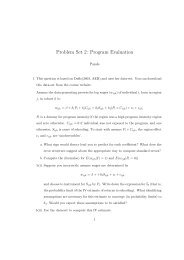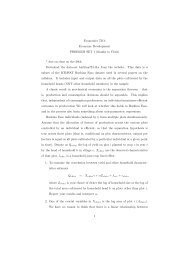The Expected Utility Model: Its Variants, Purposes, Evidence and ...
The Expected Utility Model: Its Variants, Purposes, Evidence and ...
The Expected Utility Model: Its Variants, Purposes, Evidence and ...
Create successful ePaper yourself
Turn your PDF publications into a flip-book with our unique Google optimized e-Paper software.
Journal of Economic Literature<br />
Vol. XX (June 1982),pp. 529-563<br />
<strong>The</strong> <strong>Expected</strong> <strong>Utility</strong> <strong>Model</strong>: <br />
<strong>Its</strong> <strong>Variants</strong>, <strong>Purposes</strong>, <strong>Evidence</strong> <br />
<strong>and</strong> Limitations <br />
Graduate School of Business <br />
University of Chicago <br />
<strong>The</strong> author would like to express his appreciation to David Brbe,<br />
Victor Goldberg, Paul Kleindorfer, Roger Kormendi, Michael Rothschild,<br />
<strong>and</strong> the anonymous referees for their helpful comments on<br />
earlier drafts of this article. Additionally, his colleagues in the Center<br />
for Decision Research at the University of Chicago, especially<br />
Hillel Einhorn, Robin Hogarth <strong>and</strong> J. Edward Russo, are acknowledged<br />
for stimulating discussions on the present topic. Funding<br />
for this review was received from the Graduate School of Management<br />
in Delft <strong>and</strong> the Erasmus University of Rotterdam, both in<br />
the Netherl<strong>and</strong>s. Th,eir support is much appreciated.<br />
I. Introduction research (e.g., Ward Edwards, 1961; Gor-<br />
T IS NO EXAGGERATION to consider ex-<br />
I pected utility theory the major paradon<br />
Becker <strong>and</strong> Charles McClintock,<br />
1967; Amnon Rapoport <strong>and</strong> Thomas<br />
Wallsten, 1972; Paul Slovic et al., 1977;<br />
digm in decision making since the Second Robert Libby <strong>and</strong> Peter Fishburn, 1977;<br />
World War. It has been used prescrip- Charles Vlek <strong>and</strong> Willem Wagenaar, 1979;<br />
tively in management science (especially <strong>and</strong> Hillel Einhorn <strong>and</strong> Robin Hogarth,<br />
decision analysis), predictively in finance 1981), few have attempted to organize the<br />
<strong>and</strong> economics, descriptively by psycholo- relevant evidence around the different<br />
gists, <strong>and</strong> has played a central role in theo- purposes served by the EU model. Simiries<br />
of measurable utility. <strong>The</strong> expected larly, there has been no systematic examiutility<br />
(EU) model has consequently been nation of the way various descriptive exthe<br />
focus of much theoretical <strong>and</strong> empiri- tensions of expected utility theory relate<br />
cal research, including various interpreta- to their progenitor, or of how the current<br />
tions <strong>and</strong> descriptive modifications as to normative variant differs from its historiits<br />
mathematical form. This paper reviews cal roots.<br />
the major empirical studies bearing on the In addressing these issues, the present<br />
EU model. Although previous reviews of paper first discusses various EU modificadecision<br />
making have covered some of this tions. Special attention will be given to




